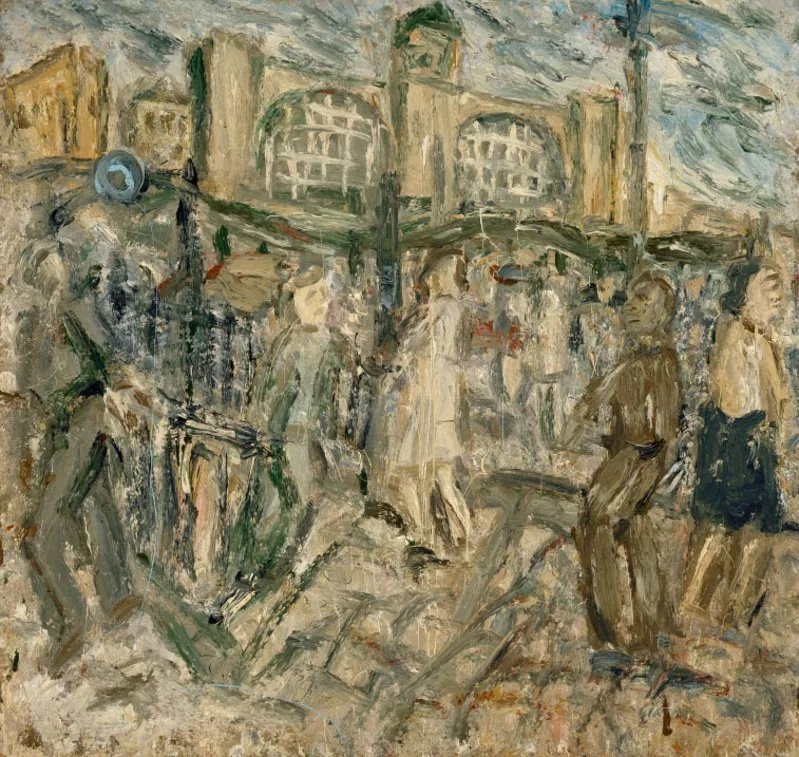That's No Fit Subject For Art
9 June 2022
Depicting the everyday has a longer history than we might think.
Francesca Peacock
Francesca Peacock is an art, books, and culture writer.
What would you pay for a mid-20th century oil painting of a football match? What if the action of the match was barely visible and the crowd only a collection of crudely drawn matchstick men, dwarfed by a cityscape of terraced houses, factories, and dark snakes of putrid smoke? A few hundred thousand pounds? A million, maybe?
Stephen Campbell, Cosy Club, The Corn Exchange, Manchester, oil on cnavas, 48" x 72"
Image courtesy of Clark Art Ltd
Back in 2011, someone coughed up rather more. L. S. Lowry’s ‘The Football Match’ (1949) sold for a record-breaking £5.6 million at Christies back in 2011. More recently, his ‘The Mill, Pendlebury’ sold for £2.6 million in 2020.
Why does it come as a shock that — despite his scarcity (Lowry painted only somewhere in the region of 2500 canvases), and fame — that his works are now so expensive? Perhaps it is his choice of subject. Lowry’s buyers are not paying millions of pounds for a colourful portrait to brighten their wall, nor for a canvas which explicitly challenges their sensibilities with brutal, unsettling, shocking abstract forms. They are buying scenes of everyday life — and northern everyday life at that. People on the way to work; on the way back from t’mill; industrial buildings and smoggy skies.
Tate Britain now holds 23 of his works, which, when they are on display, make a sharp change to the soothing “pretty-girls-in-pretty-dresses” school of art which spans the centuries from Gainsborough to John Singer Sargent. If nudes, still lifes, or bucolic rural scenes were the norm, Lowry flicked his brush in the other direction. His human figures are almost non-anthropomorphic, and it is 20th century city-life which is at the centre of the canvas. ‘Smog, Soot, Soot, Grey’ in the place of ‘Carnation, Lily, Lily, Rose’, if you will.
Lowry was, of course, not alone in choosing to make art about the urban or rural realities of everyday life. “Choosing” might be the wrong verb when thinking about the tractor and factory paintings of Soviet-era Socialist realism – not a lot of choice there — but here, too, is a non-traditional subject: workers, farm machinery, and inner-city buildings.
How does this impulse to make — and collect — paintings of every day, mundane subjects fare in the contemporary market? Bill Clark is the owner of the Cheshire-based gallery Clark Art which specialises in selling Lowry and works by the “Northern School” artists. He identifies a trend: Lowry has become “more popular than ever” in the last decade, and the prices are reflecting that. The gallery has waiting lists to buy million-pound paintings by Lowry, and most of the buyers are new. This is “not a static market”.
But the scene is not just stuck in the mid-20th century. In fact, Manchester-based artist Stephen Campbell is insistent about refuting any accusations of “nostalgia”. His work — he paints Manchester streets, Salford quays, and Stockport skateparks — is anti-romantic and anti-pretence. He paints in the tradition of Lowry, but his subjects are overwhelmingly modern. Lowry recorded mill-workers; he captures chuggers. In Campbell’s words, “people don’t like looking at the real world”, but his art is dedicated to recording “banal, everyday things”.
Burnley-born painter Liam Spencer’s work has a different feel about it: he has a Hopper-esque way with darkness and light, and a looseness of paint that makes his street-scenes look almost fluid. But his choice of subject — a car-wash lit up at night, or a chippie at twilight with a would-be customer waiting outside — is similar.
Liam Spencer, Deansgate and Whitworth Street, Manchester, oil on board, 24" x 48"
Image courtesy of Clark Art Ltd
There is democracy in painting the world as it is. These are not paintings by a coterie — either 18th century drawing rooms, or 20th century Bloomsbury acolytes — and nor are they for a coterie. Unlike the discombobulating canvases of abstract expressionism or surrealism, one needs little artistic knowledge to be able to understand and read these paintings. As Clark notes, these are works “people can relate to”. And Campbell, when talking about his choice of subject, sees “something political” in recording the mundane scenes of everyday life.
There is, perhaps, a temptation to over-state the radicalism of this anti-elitist, democratic vein. Artists have been rebelling against the idealisation of art as early as the mid-19th century Realism movement. Their subjects — portraits of peasants and workers — now seem less radical than greasy fast-food outlets and night-time cities, but there is a similarity of principle. Art has left salons, studios, and exhibitions of the elite.
This work is not just confined to the northern environs of Lowry’s homeland and the subsequent “Northern School”: Clark says that many of his biggest customers are in London and the South. “A painting of Manchester docks can sit on the wall of a house in Westbourne Grove”, he observes.
And this year’s Spring issue of the Royal Academy magazine — that bastion of West End sensibilities — features two paintings by Reuben Colley: ‘Underpass’ (2021) and ‘Estate’ (2021). Grey concrete tower-blocks and graffitied suburban infrastructure: one can almost imagine a stuffy, pince-nez’d art critic taking one look and declaring “that’s no fit subject for art”. But, with prices close to £20,000, it’s clear that many people disagree: the mundane is going up in the art world.
































